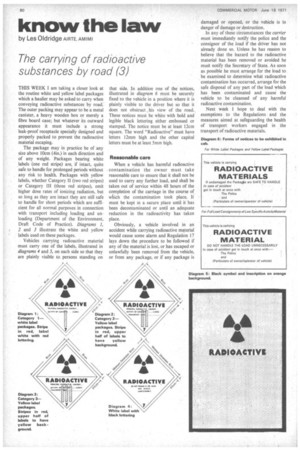know the law
Page 82

If you've noticed an error in this article please click here to report it so we can fix it.
by Les Oldridge AIRTE, AMIMI
The carrying of radioactive substances by road (3)
THIS WEEK I am taking a closer look at the routine white and yellow label packages which a haulier may be asked to carry when conveying radioactive substances by road: The outer packing may appear to be a metal canister, a heavy wooden box or merely a fibre board case; but whatever its outward appearance it must include a strong leak-proof receptacle specially designed and properly packed to prevent the radioactive material escaping.
The package may in practice be of any size above 10cm (4in.) in each direction and of any weight. Packages bearing white .labels (one red stripe) are, if intact, quite safe to handle for prolonged periods without any risk to health. Packages with yellow labels, whether Category II (two red stripes) or Category III (three red stripes), emit higher dose rates of ionizing radiation, but so long as they are intact they are still safe to handle for short periods which are sufficient for all normal purposes in connection with transport including loading and unloading (Department of the Environment, Draft Code of Practice). Diagrams 1, 2 and 3 illustrate the white and yellow labels used on these packages.
Vehicles carrying radioactive material must carry one of the labels, illustrated in diagrams 4 and 5, on each side so that they are plainly visible to, persons standing on that side. In addition one of the notices, illustrated in diagram 6 must be securely fixed to the vehicle in a position where it is plainly visible to the driver but so that it does not obstruct , his view of the road. These notices must be white with bold and legible black lettering either embossed or stamped. The notice must be at least 12cm square. The word "Radioactive" must have letters 12mm high and the other capital letters must be at least 5mm high.
Reasonable care When a vehicle has harmful radioactive contamination the owner must take reasonable care to ensure that it shall not be used to carry any further load, and shall be taken out of service within 48 hours of the completion of the carriage in the course of which the contamination took place. It must be kept in a secure place until it has been decontaminated or until an adequate reduction in the radioactivity has taken place.
Obviously, a vehicle involved in an accident while carrying radioactive material would cause some alarm and Regulation 17 lays down the procedure to be followed if any of the material is lost, or has escaped or unlawfully been removed from the vehicle, or from any package, or if any package is damaged or opened, or the vehicle is in danger of damage or destruction.
In any of these circumstances the carrier must immediately notify the police and the consignor of the load if the driver has not already done so. Unless he has reason to believe that the hazard to the radioactive material has been removed or avoided he must notify the Secretary of State. As soon as possible he must arrange for the load to be examined to determine what radioactive contamination has occurred, arrange for the safe disposal of any part of the load which has been contaminated and cause the vehicle to be cleansed of any harmful radioactive contamination.
Next week I hope to deal with the exemptions to the Regulations and the measures aimed at safeguarding the health of transport workers engaged in , the transport of radioactive materials.
































































































































